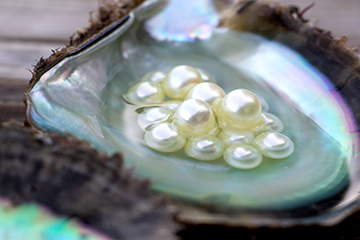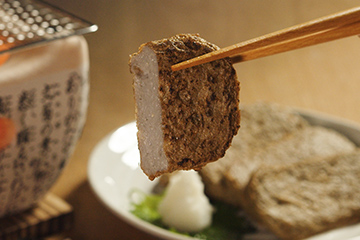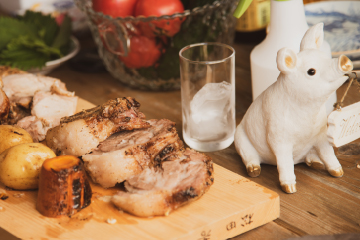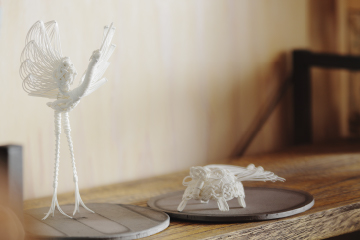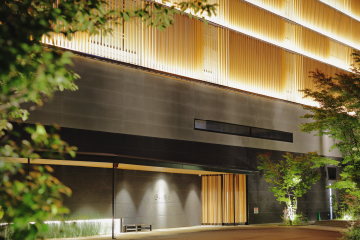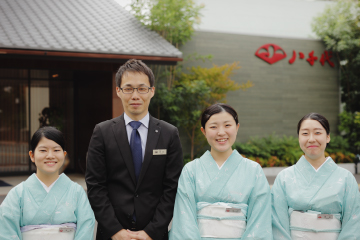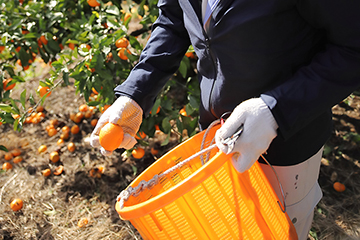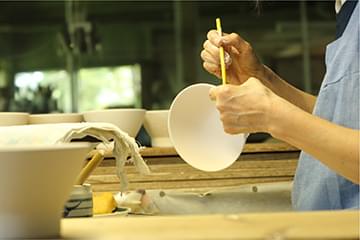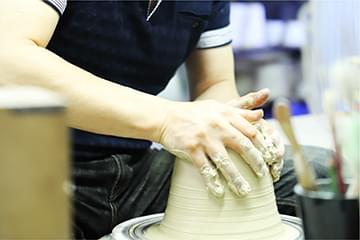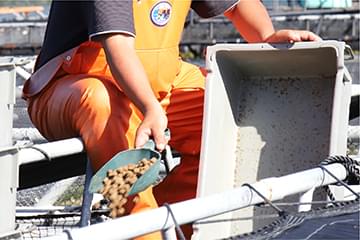Rustic, Warm, and Solid— Into the Enduring World of Tobe Ware Vol.1 Baizan-gama
Matsuyama Airport is located along the coast of the Iyo-nada Sea, the western part of the Seto Inland Sea. Endless blue sky and bright green mountains stretch inland on the drive from the airport. Entering National Route 33 and passing the Tobe Ehime Togeikan, visitors will find variously sized ceramic pots placed on the center median of the road and in front of houses.
Tobe Town in Iyo District, Ehime Prefecture, currently has about 80 pottery manufacturers. This has been a town of Tobe ware since 1775, about 240 years. We visited Baizan-gama, one such manufacturer of these traditional wares.
Founded 130 years ago, Baizan-gama is the oldest Tobe ware manufacturer. We interviewed Toshio Iwahashi, the vice president with a memorably warm smile. But behind his smile is a determination to preserve history.

Making and Painting by Hand—A Long-Standing Manufacturer Supports the History of Tobe Ware
About 40 staff members currently work to produce Tobe ware at Baizan-gama. Baizan-gama is the largest manufacturer of Tobe ware, as typical manufacturers have only one or two workers, and it has been deeply involved in the history of Tobe ware.
At the World’s Columbian Exposition of 1893 (Meiji 26) in the U.S., Tobe ware won first prize and became famous. The wares were exported to Southeast Asia, China, Indonesia, and elsewhere after the latter half of the Meiji Period. However, we had to restart our business due to the Pacific War.
Only few manufacturers remained at that time, and former president Takenosuke Umeno undertook the revitalization of Tobe ware after returning from the war.
At that time, Soetsu Yanagi, an advocate of the Mingei Movement, and ceramic artists Shoji Hamada and Kenkichi Tomimoto visited Tobe Town and gave us guidance. The Mingei Movement claimed that “beauty exists in everyday life,” that beauty is found in everyday tools rather than in artwork for admiring. The movement threw light on vanishing handicrafts throughout Japan, and this contributed to the establishment of regional mingei (folk handicraft) goods. In this context, they gave us a range of advice regarding how Tobe ware can survive. Since they highly valued our unicursal painting technique (tsuketate-kaki), we still use it today.
Baizan-gama’s current methods of making and painting wares by hand were established after much trial and error. Its fundamentals remain unchanged and have been passed down.
I believe our business kept running thanks to these methods. Manually making them one by one surely takes time, but we’d like to preserve these techniques.

Cleaning up a clay body processed with a pottery wheel. Unnecessary parts are manually removed piece by piece. The handle of a mug is attached during this process. After this, it is air dried for a few days to add durability.

After air drying, the ware goes through biscuit firing, and a rough design is drawn. At Baizan-gama, artisans carefully draw patterns by using the tsuketake unicursal drawing technique. The gosu pigment used for this is a mixture of cobalt compounds and other compounds. At Baizan-gama they use gosu produced in Tobe.

The base of soba choko cups are glazed to have smooth surfaces. The base used to be unglazed, but they were changed in response to consumer requests to avoid scratching tables.

Family and the Joy of Having Baizan Ware on the dining Table
Baizan-gama has valued consumers’ voices since its establishment. One of its best-selling items, the soba choko cup, has numerous visually pleasing designs, mainly consisting of indigo-colored hand-painted patterns.
People sometimes ask us, “Are there any uses for soba choko cups other than eating soba noodles?” I think it’s better that customers flexibly use the cups in their own ways, rather than the manufacturers define their uses. Some people use them for storing small items, and others use them as small flower vases. We are happy if our customers find joy in having our handmade products in their everyday lives. People gather at a dining table to eat while chatting with each other. If our ceramic ware is on the table to play a supporting role, we couldn’t be happier.
Thus Iwahashi spoke. His goal is “functional and beautiful”—continuously creating both beautiful and useful products for everyday life at affordable prices.
Though handmade, many of Baizan-gama’s products are reasonably priced at around 1,000 to 2,000 yen. Furthermore, it is not uncommon that the products are handed down for two or three generations, as they are characteristically less breakable—Iwahashi says “they last at least ten years.” People have used traditional wares in their homes since childhood, resulting in them developing a natural eye for it. This is perhaps a unique characteristic of the wares of Baizan-gama as well.
Baizan-gama is a pottery manufacturer with more than 130 years of history. I don’t believe it should be closed this generation. To that end, it is important to have more people know about Tobe ware. There are no two identical products, since they are all handmade and hand painted. We are happy if customers can appreciate that.

“We’d like to continue to make products that are loved by everyone and are affordable for everyone. It is true that manually making a large number of products while keeping costs low is hard. However, we’d like to keep our philosophy unchanged,” said Iwahashi. More than 5,000 types of Tobe ware are produced at Baizan-gama, which is truly amazing considering how much time and effort are spent on each piece.
Tobe ware was born in Tobe Town, a region abundant in whetstone. Various products have been created over many years. The history of manual production continues without change. Its attractiveness will be widely conveyed in the future, and Tobe ware will enrich people’s lives.
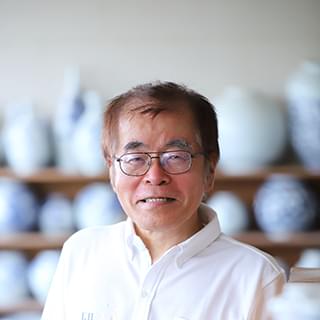
TEL:+81-89-962-2311
https://baizangama.jp/
https://www.facebook.com/baizangama/
https://www.instagram.com/baizangama/






